Costa Brava (Province of Girona) - a brief introduction
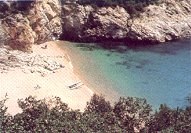 The following text is meant to give the traveller a preview of some of the Costa Brava's main points of interest. For a more in-depth guidebook intended to accompany the visitor step by step, the author of this text has written the most substantial of existing guidebooks to the Province of Girona. This 85-page Insider's Guide, with practical and detailed information on sights as well as listings for restaurants, markets, festivals, etc., is yet to be published, but loan copies are available at all of the rental properties we handle.
The following text is meant to give the traveller a preview of some of the Costa Brava's main points of interest. For a more in-depth guidebook intended to accompany the visitor step by step, the author of this text has written the most substantial of existing guidebooks to the Province of Girona. This 85-page Insider's Guide, with practical and detailed information on sights as well as listings for restaurants, markets, festivals, etc., is yet to be published, but loan copies are available at all of the rental properties we handle.
1) From Barcelona to the Costa Brava: most of you will be travelling by car from Barcelona to the Costa Brava. If you leave directly from Barcelona Airport then you simply follow the blue signs for the AP-7 marked "Girona" and "Francia". This will lead you around metropolitan Barcelona and the Province of Girona begins in 70 kilometers, 90 kms to the town of Girona. If you are staying in Barcelona before heading north, the best way to get out of town is to take the Barcelona ring road to either the AP-7 or the C-32 going north. From the old town, you can get on the ring road, called the Ronda Litoral, from the Pla de Palau, the large plaza separating Barceloneta and the beaches from Barcelona's old town. The access ramp (marked nº 22) is on your left just before the Olympic twin towers, about 100 meters after leaving the wide Pla de Palau traffic circle. If you miss it, don't worry. There is another ramp (nº 23) a kilometer further on.
Once you are on the B-20 or Ronda Litoral, you must choose between the two highways. Look for the distinctive blue signs for Autopistas, or toll roads. The C-32 comes up first. It is new, inexpensive, and becomes increasingly scenic as it follows the coastline north... But it ends just below Blanes and is only convenient to those going to the lower Costa Brava. The AP-7 from Barcelona is faster and more expensive, and is recommended for those in a hurry to get to the mid or northern Costa Brava. You can always switch over to the AP-7 after the C-32 ends, but it isn´t fast going.
2) The Costa Brava coast: while much of the coast, like elsewhere on the Mediterranean, has suffered the effects of tourism, this is still one of the most stunningly beautiful parts of the Mediterranean anywhere. Choose well your route and you will be able to bypass some of the tourist traps that mire an otherwise gorgeous coastline.
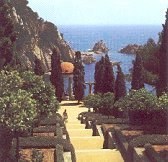 Blanes*- quite a built up resort town with an old center fronted by long beach-front promenade, then a marina, then and fishing port with good seafood restaurants. Above town is the magnificent Botanical Gardens of Marimurtra***, a splendid way to start your visit to the Costa Brava. Just beyond the Marimurtra Gardens is the first real cala, or sandy cove beach of the Costa Brava - far more romantic than Blanes' wide beach.
Blanes*- quite a built up resort town with an old center fronted by long beach-front promenade, then a marina, then and fishing port with good seafood restaurants. Above town is the magnificent Botanical Gardens of Marimurtra***, a splendid way to start your visit to the Costa Brava. Just beyond the Marimurtra Gardens is the first real cala, or sandy cove beach of the Costa Brava - far more romantic than Blanes' wide beach.
Lloret de Mar- a fairly tacky tourist trap which has only its beach to recommend it. A resort town full of discoteques and fast food joints best seen at 30 km per hour on your way to Tossa de Mar.
Tossa de Mar**- a pleasant low-key resort town that has retained much of its charm due to good urban planning. The Vila Vella with its 12th C walls is a gem, and the old town is full of good restaurants. The beach has nice coarse sand, and there is a very handy municipal parking lot just below the old town walls on the beach.
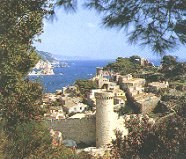 The Corniche***- the winding 22-kilometers between Tossa de Mar and Sant Feliu de Guíxols is one of the most breathtakingly beautiful stretches of coastline you are likely to see anywhere. The road twists and turns through red cliffs of luxuriant pine and cork groves, affording splendid views of jutting headlands and small calas of sparkling blue water. Take your time to explore the beaches along here.
The Corniche***- the winding 22-kilometers between Tossa de Mar and Sant Feliu de Guíxols is one of the most breathtakingly beautiful stretches of coastline you are likely to see anywhere. The road twists and turns through red cliffs of luxuriant pine and cork groves, affording splendid views of jutting headlands and small calas of sparkling blue water. Take your time to explore the beaches along here.
Sant Feliu de Guíxols*- is another pleasant town with a difference. Like Blanes, this isn't just a resort but a real town with a busy fishing port as well as a fine beach, and there is an attractive market place surrounded by good and moderately priced restaurants in the old town behind the attractive sea-front promenade. The town museum has a interesting exhibit dedicated to the town's important cork industry, with all manner of artifacts fashioned from this spongy bark.
Santa Pol*- is a tiny resort just above Sant Feliu with a wide dune-backed beach. At the northern part of this beach lies the semi-private up-scale resort of S'Agaro, playground of Hollywood stars in the '50's. You can walk in to reach some very nice calas, but car access is restricted to guests and residents.
Platja d'Aro- is the second biggest tourist trap on the coast, and is "saved" by the low pines that line the streets - effectively hiding much of the urban blight. Very long nice beach here, though... particularly between Platja d'Aro and Sant Antoni just north of town, with that little islet / promentory that features in so many promotional photos for the region.
Palamós- used to be nice, but the old town has been swallowed up by sky scrappers that stick up everywhere like sore thumbs. Much nicer is the tiny resort of La Fosca** just to the north of town. To be fair, Palamós does still have an old town and some very reputable restaurants, a the daily catch is still auctioned to the public on the quaysides in the afternoons.
Palafrugell*- is slightly inland and distributes traffic (and I mean traffic!) to some of the coast's best small-scale resorts. Calella de Palafrugell*** is genuinely charming, with its low-rise and arcaded whitewashed houses, its five little beaches, and its Botanical Garden at Cap Roig**. The nearby towns of Llafranc** and Tamariu** are also very appealing, with good if somewhat pricey restaurants. The view from the lighthouse at el Far de Sant Sebastià*** is well worth the climb.
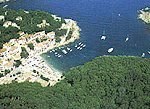 Begur*- like Palafrugell, distributes traffic to a hand-full of small upscale resorts such as Aiguafreda, sa Tuna, Fornells, and Aiguabrava, all but the latter of which deserve their stars**. The detrimental influence of a ill-conceived Parador Nacional has all but ruined the charming site of Aiguabrava. The hilltop town of Begur itself is somewhat dull but charming, full of turn-of-the-century villas, some of which have recently been restored.
Begur*- like Palafrugell, distributes traffic to a hand-full of small upscale resorts such as Aiguafreda, sa Tuna, Fornells, and Aiguabrava, all but the latter of which deserve their stars**. The detrimental influence of a ill-conceived Parador Nacional has all but ruined the charming site of Aiguabrava. The hilltop town of Begur itself is somewhat dull but charming, full of turn-of-the-century villas, some of which have recently been restored.
L'Estartit*- deserves its star not for its English and German pubs, nor for its souvenir shops, but perhaps for its wide beach and whitewashed old town - and especially because it where one departs by boat to the wonderful Illes Medes***, a cluster of seven ecologically protected islands with coral reefs that are a diver's - dare I say it - wet dream. Whether you scuba, snorkel, or simply sit in a glass-bottom boat looking down, be sure to visit these islands. Torroella de Montgris* is five kilometers inland from l'Estartit, and is well worth a visit, with its porticoed plazas and narrow streets all under the watchfull eye of its 13thC castle. In between the two towns is parklands worth exploring.
L'Escala**- is another village which is bloated with tourists in summer... but there is something about this fishing village which refuses to succumb to the onslaught. I don't know what it is - probably the excellent restaurants like the ones on the quayside - but I find I'm often drawn back to this rather drab town. Just north of town is one of the coast's premiere historical sites, the Greco-Roman ruins at Empúrias***. The site and the ruins combined with excellent beaches are a winning combination.
The Gulf of Roses is the area´s longest and widest beach and you are allowed to drive onto the dunes and park. The beach is usually windy and has lots windsurf and kitesurf rentals.
Roses- is the largest town on the wide golf of Roses. This area offers a bit of everything to everyone. For the beachcomber, there is the long white beach; for the ecologist and bird-watcher there is the important nature reserve at Aiguamolls de l'Empordá**, for hapless campers there are some mosquito-ridden trailer lots, and for the Mittel-European tourist with a bit of money to spend, there is the horrendous Empúriabrava resort, an enormous concrete pseudo-Venice of identical chalets backed by canals so that you can yacht from your back yard. The town of Roses doesn't stand a chance in such surroundings, despite the old town and the ruins of its large Citadel, you would probably do well to press on to the nice beaches and good restaurants beyond Roses on the Cape towards Cadaqués and the French border.
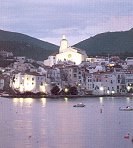 Cadaqués***- is undoubtedly the nicest of the resorts on the Cape, along with Port de la Selva and Llançà. The town is delightful, particularly in the off season. Beyond Cadaqués is Portlligat and the Cap de Creus, the eerily beautiful, barren and wind-swept landscape which inspired the region's most universal son, Salvador Dalí.
Cadaqués***- is undoubtedly the nicest of the resorts on the Cape, along with Port de la Selva and Llançà. The town is delightful, particularly in the off season. Beyond Cadaqués is Portlligat and the Cap de Creus, the eerily beautiful, barren and wind-swept landscape which inspired the region's most universal son, Salvador Dalí.
Above Llança are the 10thC remains of Benedictine Sant Pere de Rodes***. Once again, the site is a impressive as the sights. Inland from Sant Pere de Rodes is a wine-growing area renowned for its megalithic monuments and ruined Romanesque monasteries (like the almost inaccessible Sant Quirze de Colera).
3) Inland: you need only venture a few kilometers inland to find pristine agricultural lands and ancient stone villages that seem worlds away from the often built-up coast. This is what is most interesting to me about the Costa Brava. Here is a brief selection of some nice towns, starting due east of Girona and circling around counterclockwise, and ending with Girona-capital itself. No need to give stars here - any of the few towns mentioned more than justify the detour.
Monells is a tiny village with a double-porticoed square, one café, two restaurants, and no souvenir shops. (It is evidently not on the tourist route, and I trust this website is still too marginal to influence its destiny...)
Cruilles- has one remaining Medieval observation tower and an impressive Romanesque church on the outskirts of town.
Peretallada- the name means cut-in-stone, and many of the narrow streets and building foundations are just that, carved right into the natural bedrock. Park in front of Sant Esteve across the road from town, crossing the moat which is cut several meters directly into the living bedrock!! The town is simply delightful, and there are plenty of restaurants.
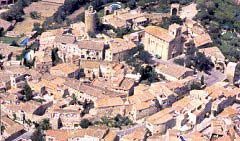 Pals- is very much on the tourist track - there is even a huge parking lot for buses. But despite this and some over-restoration of historic buildings, not to mention a few tacky ceramic souvenic shops, the town and surrounding area is truly gorgeous and worth a visit, particularly in the off-season.
Pals- is very much on the tourist track - there is even a huge parking lot for buses. But despite this and some over-restoration of historic buildings, not to mention a few tacky ceramic souvenic shops, the town and surrounding area is truly gorgeous and worth a visit, particularly in the off-season.
Ullastret is another Medieval precinct surrounded by several layers of perimeter walls. Nearby, the Iberian settlement of Ullastret is a fascinating archeological site dating from the seventh century BC. The site is lovely, its slighly elevated position affording great views, and the ruins are eloquent testimony of the advanced complexity of this proto-Iberian settlement, with cisterns and water canalization, surrounded by cyclopean walls of huge beautifully hewn stones!
Figueres- is a relatively big and bustling town famous for its Teatre-Museu Dalí, which, after the Prado in Madrid, is Spain's most visited museum. Figueres also boasts a good Toy Museum and Europe's largest fortress, the Castell de Sant Ferran. To the east of Figueres lies a cluster of very attractive Medieval towns: Castelló d'Empúries, with its 13C Cathedral of Santa Maria; Perelada, site of an impressive castle now turned into a casino; and Vilabertran, with its large 11C monastery, which hosts a Schubert festival in September.
Lladó d'Empordá- to the west of Figueres is a fine example of well kept Medieval village that is yet unknown to most tourists... and with a good restaurant and a jazz bar.
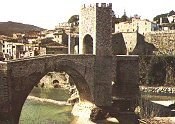 Besalú- boasts some monuments completely out of proportion to its current status as a small agricultural village. The 11C fortified bridge alone would put this town on the map, but Besalú also boasts the remains of a Mikwah, or Jewish ritual bath house, two large Romanesque churches, an 11C hospital and a 12C monastery. Despite the odd busload of you-know-whats, the place is utterly authentic.
Besalú- boasts some monuments completely out of proportion to its current status as a small agricultural village. The 11C fortified bridge alone would put this town on the map, but Besalú also boasts the remains of a Mikwah, or Jewish ritual bath house, two large Romanesque churches, an 11C hospital and a 12C monastery. Despite the odd busload of you-know-whats, the place is utterly authentic.
Banyoles- was site of the 1992 Olympic rowing events. The enviornmentally protected lake is surrounded by shaded footpaths and the odd pier for swimmers and rowers, the distant snow-peaked Pyrenees reflected from the amazingly clear waters. The town itself is full of Medieval buildings and there are a couple of good museums. The porticoed square, with its biweekly market dating back to the 11thC, is a great place to have a drink and a tapa at a terrace café.
Santa Pau- is a fortified Medieval village with double-porticoed square and flower-draped wood balconies in the heart of the Garrotxa Volcanic Park, Europe's largest region of (extinct) volcanoes. Take time to get to know the Garrotxa region - to the west of the lake, and the Pla de l'Estany region - to the east of the lake. The rewards are many: lovely rolling hillsides, pristine stone villages, great food and drink...and few tourists!... all within a few minutes of the Pyrenees and the beaches.
Caldes de Malavella- is to the south of Girona and is just one of the many spa towns with hot springs and sparkling mineral water in this area. Many of the spa towns here and in the nearby Montseny Mountains have flamboyant art-nouveau spa hotels specializing in all sorts of hydrotherapy, mudbaths, messages, and other health treatments. The Roman baths here are undergoing renovation.
Girona- once you penetrate the industrial/shopping mall belt which surrounds it, Girona is an overwhelmingly beautiful Medieval city. Girona, "city of a thousand seiges," stands fortress-like on a hill at the confluence of two rivers, the old-town's Medieval wall protecting the monumental legacy of its erstwhile inhabitants. Girona has it all: Roman ruins, Jewish quarter, Arab baths, Romanesque churches, early Gothic Cathedral (with the world second widest nave - outdone by Sant Peter's by 2 meters), Gothic chuches, Charlemagne's Tower, museums, modernist buildings, parks, etc... Girona is a must-see... but most tourists don't bother. Perfect!
4) The Mountains: The Pyrenees form an integral part of the Costa Brava, but surprisingly few tourists venture more than a few kilometers inland from the beaches. This is a shame - for the tourists. The interplay between sea and mountain, or if you prefer, sailor, farmer, and hunter, is what forged the spirit and character of the Catalans. A visit to Catalonia without visiting the mountains is quite simply a mistake.
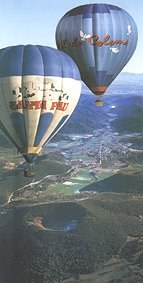 Olot- is as good place to start as any, a prosperous town completely surrounded by volcanic cones masked by lush vegetation. The old town is full of fashionable shops and squares, some flanked by art-nouveau buildings, and there is a good museum and botanical garden. Hit the road from Olot in any direction and you are bound to see great mountain scenery dotted with huge stone masias (farmhouses) and unspoilt Medieval villages.
Olot- is as good place to start as any, a prosperous town completely surrounded by volcanic cones masked by lush vegetation. The old town is full of fashionable shops and squares, some flanked by art-nouveau buildings, and there is a good museum and botanical garden. Hit the road from Olot in any direction and you are bound to see great mountain scenery dotted with huge stone masias (farmhouses) and unspoilt Medieval villages.
Sant Joan de les Abadesses- is best reached from Olot by way of the Vall de Bianya on the C-26. While Sant Joan is not the most exciting of mountain villages but the fabulous monastery here is absolutely first-rate. The 2-Euro entry free combines a visit to the Church, consecrated in 1150, with its stunning polychrome wooden altarpiece representing the Descent from the Cross, cloisters with fine capitals, and a small museum with an interesting, if poorly labeled, collection.
Camprodon- lies to the north of Sant Joan. This prosperous village has a tall 15thC arched bridge with a defensive tower, a couple of worthy Romanesque chuches, and some art-nouveau villas. But perhaps more importantly, Camprodon is the springboard for some worthy excursions. The most challenging of these (for the winding road) is the 15-km stretch to Beget, a truly lovely stone and slate village staddling a stream with an elegant parish church conserving magnificent 11thC frescos. Beget is not unique in Catalonia, but for my tastes, it is near perfect.
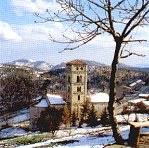 Nearby Molló is also worth the detour, and you can cross into France 10 km beyond at the Coll d'Ares, or go up the other scenic valley to the ski resort at Setcases.
Nearby Molló is also worth the detour, and you can cross into France 10 km beyond at the Coll d'Ares, or go up the other scenic valley to the ski resort at Setcases.
Ripoll- is admittedly a rather gloomy once-industrial town, but do make a point of seeing the main portal of the monastery, one of the single most important Romanesque monuments in Spain. The adjacent Museu dels Pirineos has an ecclectic collection ranging from metal work (for which Ripoll was famous in the 17thC) to assorted Civil War memorabilia
. 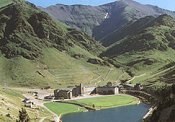
Ribes de Freser- is a pleasant riverside town with a busy outdoor market... but Ribes is best known for the Cremallera, a private railway line that climbs spectacularly for 45 minutes into the valley of the Santuario de Núria, a favorite spot for hikers. The Cremallera is highly recommended.
Puigcerdá- is the last major town in the Province of Girona, and is reached from Ribes de Freser by way of a scenic high mountain road, the N-152. Roadsigns point to picturesque villages of slate and stone, such as Dòrria and Toses, at 2000 meters altitude. Recently, Dòrria's hermitage was found, during some long-overdue routine cleaning, to have some perfectly preserved frescos dating from the late 12thC, hitherto concealed under five coats of plaster. Just an example of the sort of wonders awaiting those who dare to explore the interior of this amazingly rich province!
